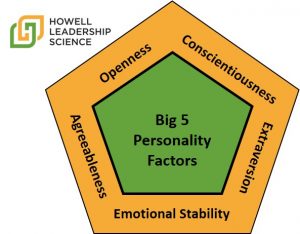
Every person is a unique mishmash of personality traits, experiences, physical characteristics, upbringing, intelligence and more.
But situations – like workplaces – cannot be customized for each unique individual. So, psychologists categorize personalities in order to better understand human behavior – at least some small part of it.
This understanding allows us to design workplaces that support employees in thriving and doing their best work.
This post will introduce you to the Big 5 personality factors. These factors will appear in many of the research studies discussed on this blog.
What are the Big 5 personality factors?

The Big 5 refers to a model for categorizing personality traits – centered on five key factors or traits.
Developed using a statistical technique called factor analysis, the Big 5 taxonomy is the most research-supported model of personality.
Different researchers have consistently found these same five variables – although they sometimes used different names for the traits. This lends validity to the model.
Even so, personality is a squishy construct and very hard to measure.
Understanding personality helps us understand how to work better and succeed in life. It supports work-related processes such as identifying high potential employees. But keep in mind that measures of personality are not perfect and will keep evolving due to ongoing research.
Key facts about the Big 5
The Big 5 includes five primary personality traits: Openness to experience, conscientiousness, extroversion, agreeableness, and emotional stability (neuroticism)

- The Big 5 is also known as ‘The Five Factor Model’ and by acronyms based on the factors: OCEAN and CANOE
- The five factors tend to be relatively stable from childhood through adulthood. But people can learn to control their tendencies and behave differently.
- Personality traits work on a continuum. People are rarely at the extremes – having a very high level or a very low. Most of us are somewhere in between. Extremes can lead to problems.
- There are benefits and downsides to both high and low levels of each trait. Different traits flourish in different situations.
- The five traits also interact with each other and can influence how they are displayed.
- Many assessments are based on the Big 5. These assessment help people understand their own tendencies, so they can tweak behaviors where needed.
- The Big 5 model does not cover every aspect of personality. There are other traits like narcissism and charisma that might be more relevant in certain situations.
- Although regarded as the strongest model of personality, all personality research is challenging and the model remains controversial.
Definitions of the Big 5 Personality Traits
Find high-level definitions of the five factors below. Each definition specifies what a high amount and a low amount look like. But remember, most people fall somewhere in the middle of the continuum.

Openness (to experience)
Openness to experience – or openness for short – refers to a person’s tendency to be intellectually curious, sensitive to beauty and willing to try new things.
- High openness: People who are high in openness tend to be curious, open to different experiences and sometimes hold unconventional beliefs. Although more likely to seek self-actualization, they can also be unpredictable, lack focus and partake in risky behavior.
- Low openness: People on the low end of the openness continuum lean toward being pragmatic and data-driven with a tendency to be dogmatic and close-minded.
Conscientiousness
Conscientiousness centers on a person’s tendency to show self-discipline, act dutifully, strive to accomplish goals and have impulse control.
- High conscientiousness: High conscientious people like order and calm as reflected in having strong impulse control. They usually excel at getting work done. Extremely high conscientiousness can result in someone acting stubborn and overly focused.
- Low conscientiousness: People with low conscientiousness tend to be more flexible and spontaneous which can sometimes turn into being sloppy and unreliable.
Extraversion
Extraversion explains how people prefer to interact with the world.
- High extraversion: Generally extraverts enjoy engaging with the world and other people. They tend to have high energy, enjoy groups and prefer action. They get energy from external sources.
- Low extraversion (introversion): Introverts rate low on the extroversion trait of personality. They tend to interact with the world in a different way due to lower social energy. Introverts tend to be quieter and more deliberate. Being more independent, they are less interested in constant social interaction. Being introverted does not make someone anti-social or shy. It simply means that they tend to be more reserved in social situations and need time alone to re-charge.
- Extraversion/ introversion has experienced a moment of fame in the broader world. Several books detail the benefits of one or the other. This trait has turned into label instead of a descriptor. Remember, that extraversion works on a continuum and people can succeed regardless of their place on the scale.
Extraversion rabbit hole
As I admit in my bio, curiosity is my superpower – I tend to be high in openness. My curiosity brings value, but it also takes me down some odd side roads and rabbit holes.
As I wrote this article, my spell check and I did not agree on how to spell ‘extraversion’, so I did the logical thing and Googled it. Sure enough, I was not the only one with this question.
In 2015, Beautiful Minds author Scott Barry Kaufman wrote an article called “The Difference between ExtrAversion and ExtrOversion” which ran on the Scientific American blog.
He found that the original term, coined by Carl Jung is extraversion- with an ‘a’. We’ll use that version.
Kaufman’s article mentions the Big 5 personality factors and is also fun to read – at least in a geeky sort of way. And he demonstrated his own geekiness by writing: “Jung was THE BOMB DIGGIDITY (which, by the way, I wish was an official term in the Oxford dictionary)”.
You gotta love the enthusiasm. If you are interested in words, or extraversion or the Bomb Diggidity Carl Jung, check out the article.
Agreeableness
Agreeableness measures a person’s interest in social harmony.
- High agreeableness: High agreeable people value relationships and getting along with others. Tending towards optimism, they are usually considerate, trusting, helpful and willing to compromise.
- Low agreeableness: People lower in agreeableness often focus on themselves instead of others. This can result in them being more suspicious, unfriendly and argumentative.
- As a social trait, agreeableness influences relationships with other people. Higher agreeableness correlates with stronger relationships -including those at work. Some research indicates that agreeableness positively predicts skill with transformational leadership.
Emotional Stability (Neuroticism)
The final Big 5 trait goes by two different names. Originally labeled as ‘neuroticism’, later researchers re-named it as ‘emotional stability’ to focus on the positive. Emotional stability measures the ability to manage negative emotions such as anger, anxiety and depression.
- High emotional stability (low neuroticism): People with high emotional stability manage their emotions and reactions well. They do not get upset easily and are less emotionally reactive.
- Low emotional stability (high neuroticism): People with low emotional stability have sensitive temperaments. They tend to respond emotionally to most situations and have difficulty handling stress. Easily frustrated, they see minor frustrations as major challenges. With difficulty managing emotions, their negative reactions often persist for a long time leading to them being in a bad mood or upset state. They have challenges in regulating emotional responses and often over-react to situations.
You’ll see the Big 5 personality traits pop up in many of the research studies translated on this blog. For example, an earlier article considered the impact of personality on manager transitions.




Yes, that’s true almost all the individual come within this group. The combination of these five-factor decides the personality of the individual. This can be used in many places. A person’s individual personality differs only with these 5 traits either they have different combination of high or low in all these factors.